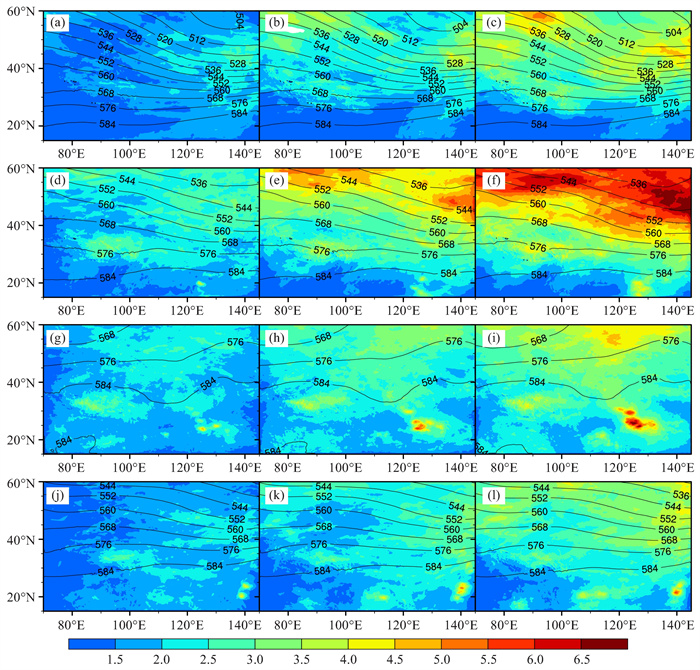Characteristics of Spatio-temporal Inhomogeneities in the Growth of Ensemble Forecast Perturbations in East Asian Monsoon Region
-
摘要: 为深入认识东亚季风区集合预报扰动增长的时空变化特征,以更好地改进该区域集合预报扰动结构,基于中国气象局区域集合预报模式(CMA-REPS),利用2021年1—12月集合预报结果,选取扰动能量、离散度和集合一致性等评估指标,对比分析不同纬度风场和温度场集合预报扰动增长的时空变化特征,并分析了一次典型降水过程的集合预报扰动增长特征。(1) 集合预报扰动增长过程中集合离散度时空分布具有纬度带差异和季节特征。离散度大小呈现由北向南递减趋势。在45~60 °N、30~45 °N区域,集合预报离散度的最大值通常出现在春季,这与大气环流季节转换、冷暖空气交汇等相关,具有明显的流依赖特征,而在15~30 °N低纬区域的集合预报离散度最大值则通常出现在夏季,这与台风活动有关。同时值得关注的是青藏高原地区表现为一个集合离散度大值区,可能与青藏高原大地形对预报扰动增长影响有关。(2) 预报扰动增长过程中,集合一致性的时空分布特征与离散度基本一致。45~60 °N、30~45 °N中高纬度区域的集合一致性在春季更接近1;在15~30 °N低纬地区,集合一致性夏季更接近1,但各季节一致性均明显偏小。(3) 集合预报扰动能量及其增长率的垂直分布同样具有显著的纬度差异和季节差异。在45~60 °N、30~45 °N中高纬度区域,扰动总能量在高层和低层存在大值区,最大值出现在春季;在15~30 °N低纬区域扰动总能量偏小且随高度变化不明显,而且各季节扰动能量增长率也偏小,说明需要特别发展低纬区域集合预报扰动方法。集合预报扰动增长表现出的季节性、流依赖性和区域变化等特征,表明东亚季风区的集合扰动方法需要针对不同纬度和不同季节进行分别研究,尤其需要关注低纬区域集合预报扰动结构调整。Abstract: This study aims to gain a deeper understanding of the spatio-temporal evolution characteristics of the growth of ensemble perturbations so as to better improve the structure of ensemble forecast perturbations in the East Asian monsoon region. Using the China Meteorological Administration-Regional Ensemble Prediction System (CMA-REPS) and ensemble forecast results from January to December 2021, we analyzed and compared the spatio-temporal characteristics of perturbation growth in wind and temperature fields at different latitudes. Evaluation indexes such as perturbation energy, ensemble spread, and ensemble consistency were employed. Moreover, the growth characteristics of ensemble forecast perturbations during a typical precipitation event were examined. The results show that: (1) The spatio-temporal distribution of ensemble spread in the process of ensemble forecast perturbations growth showed latitude zone difference and seasonal characteristics. The value of the ensemble spread showed a decreasing trend from north to south. In the 45-60 ° N and 30-45 ° N regions, the maximum value of ensemble spread usually occurred in spring, which was related to seasonal transitions in atmospheric circulation and the convergence of cold and warm air masses. This demonstrated a clear flow-dependence in the evolution of ensemble spread. However, the maximum value of ensemble spread in the 15-30 °N low-latitude region usually appeared in summer, which was related to typhoon activities. Notably, the Qinghai-Tibet Plateau exhibited a region of high ensemble spread, likely due to the influence of its topography on perturbation growth. (2) The spatio-temporal distribution of ensemble consistency during the perturbation growth process was highly consistent with the spread. The ensemble consistency was closer to 1 in the spring in the 30-45 °N and 45-60 °N mid- to high-latitude regions, and the ensemble consistency was closer to 1 in the summer in the low-latitude region of 15-30 °N. By contrast, the consistency in all seasons was significantly smaller. (3) The vertical distribution of ensemble forecast perturbation energy and its growth rate also exhibited significant latitudinal and seasonal differences. In the 30-45 °N and 45-60 °N mid- to high-latitude regions, perturbation energy showed high values in both upper and lower levels, with the maximum occurring in spring; in the low-latitude region of 15-30 °N, the total perturbation energy was small and did not change significantly with height, and the growth rate of the perturbation energy in all seasons was relatively small, indicating the need for the development of specific ensemble forecast perturbation methods for low-latitude regions. The observed seasonal, flow-dependent, and regional variations in ensemble perturbation growth highlight the necessity of conducting separate studies for different latitudes and seasons in the East Asian monsoon region, particularly with regard to adjusting the ensemble perturbation structure in low-latitude regions.
-
图 2 同图 1,但为500 hPa温度场离散度(单位:℃)
图 4 同图 3,但为温度场(单位:℃)
图 6 同图 5,但为500 hPa温度场
图 8 同图 7,但为500 hPa温度场区域平均一致性
表 1 CMA-REPS区域集合预报系统参数配置
表 2 不同季节不同区域与全区域500 hPa纬向风离散度的差异q
区域 1月 4月 7月 10月 24 h 48 h 72 h 24 h 48 h 72 h 24 h 48 h 72 h 24 h 48 h 72 h 全区域离散度 1.64 2.16 2.81 2.10 3.09 4.03 1.95 2.38 2.84 1.72 2.15 2.63 RH差值 0.08 0.54 0.77 0.32 1.14 1.58 0.11 0.36 0.62 -0.06 0.22 0.56 RM差值 0.15 0.16 0.26 0.11 -0.07 0.00 0.04 0.00 -0.11 0.07 0.08 0.05 RL差值 -0.22 -0.73 -1.15 -0.40 -1.17 -1.81 -0.13 -0.30 -0.42 -0.04 -0.26 -0.57 表 3 不同季节不同区域与全区域500 hPa温度场离散度的差异
区域 1月 4月 7月 10月 24 h 48 h 72 h 24 h 48 h 72 h 24 h 48 h 72 h 24 h 48 h 72 h 全区域离散度 0.45 0.67 0.93 0.59 0.99 1.40 0.50 0.64 0.78 0.44 0.59 0.78 RH差值 0.01 0.14 0.22 0.18 0.54 0.81 0.04 0.18 0.28 0.01 0.13 0.25 RM差值 0.04 0.07 0.10 0.00 -0.13 -0.20 0.04 0.02 0.00 0.05 0.05 0.06 RL差值 -0.06 -0.23 -0.38 -0.17 -0.52 -0.86 -0.08 -0.19 -0.29 -0.06 -0.18 -0.33 -
[1] 黄荣辉, 杜振彩. 全球变暖背景下中国旱涝气候灾害的演变特征及趋势[J]. 自然杂志, 2010, 32(4): 187-195, 184. [2] 张颖娴, 孙劭, 刘远, 等. 2021年全球重大天气气候事件及其成因[J]. 气象, 2022, 48(4): 459-469. [3] 刘远, 李莹, 郭增元, 等. 2022年全球重大天气气候事件[J]. 气象, 2023, 49(9): 1 142-1 148. [4] MASSON-DELMOTTE V, ZHAI P, PÖRTNER H O, et al. IPCC Summary for Policymakers: Global Warming of 1.5℃[M]. Cambridge and New York: Cambridge University Press, 2022. [5] 龚志强, 王艳娇, 王遵娅, 等. 2013年夏季气候异常特征及成因简析[J]. 气象, 2014, 40(1): 119-125. [6] 苏丽欣, 石晨, 沈柏竹, 等. 2022年东亚夏季副热带季风异常活动监测分析[J]. 气象灾害防御, 2023, 30(2): 1-5. [7] 黄荣辉, 顾雷, 陈际龙, 等. 东亚季风系统的时空变化及其对我国气候异常影响的最近研究进展[J]. 大气科学, 2008, 32(4): 691-719. [8] 赵宗慈, 罗勇, 黄建斌. 全球变暖与旱涝事件[J]. 气候变化研究进展, 2023, 19(02): 258-262. [9] 张井勇, 何静, 张丽霞, 等. 面向碳中和的"一带一路"气候变化主要特征与灾害风险研究[J]. 中国科学院院刊, 2023, 38(9): 1 371-1 386. [10] LORENZ E N. Deterministic Nonperiodic Flow[J]. J Atmos Sci, 1963, 20(2): 130-141. [11] LORENZ E N. A study of the predictability of a 28-variable atmospheric model[J]. Tellus, 1965, 17(3): 321-333. [12] 李泽椿, 陈德辉. 国家气象中心集合数值预报业务系统的发展及应用[J]. 应用气象学报, 2002, 13(1): 1-15. [13] 陈静, 薛纪善, 颜宏. 华南中尺度暴雨数值预报的不确定性与集合预报试验[J]. 气象学报, 2003, 61(4): 432-446. [14] 杜钧, 陈静. 单一值预报向概率预报转变的基础: 谈谈集合预报及其带来的变革[J]. 气象, 2010, 36(11): 1-11. [15] 杜钧, 李俊. 集合预报方法在暴雨研究和预报中的应用[J]. 气象科技进展, 2014, 4(5): 6-20. [16] LEITH C E. Theoretical skill of Monte Carlo forecasts[J]. Mon Wea Rev, 1974, 102(6): 409-418. [17] 陈静, 李晓莉. GRAPES全球/区域集合预报系统10年发展回顾及展望[J]. 气象科技进展, 2020, 10(2): 9-18. [18] 杜钧. 集合预报的现状和前景[J]. 应用气象学报, 2002, 13(1): 16-28. [19] MAGNUSSON L, LEUTBECHER M, KALLEN E. Comparison between singular vectors and breeding vectors as initial perturbations of ECMWF ensemble prediction system[J]. Mon Wea Rev, 2008, 136(11): 4 092-4 104. [20] 王婧卓, 陈法敬, 陈静, 等. GRAPES区域集合预报对2019年中国汛期降水预报评估[J]. 大气科学, 2021, 45(3): 664-682. [21] 邓国, 戴玲玲, 周玉淑, 等. CMA高分辨区域集合预报系统支撑北京冬奥会气象服务保障的评估分析[J]. 气象, 2022, 48(2): 129-148. [22] 陈静, 陈德辉, 颜宏. 集合数值预报发展与研究进展[J]. 应用气象学报, 2002, 13(4): 497-507. [23] 陈静, 薛纪善, 颜宏. 一种新型的中尺度暴雨集合预报初值扰动方法研究[J]. 大气科学, 2005, 29(5): 717-726. [24] 张涵斌, 智协飞, 陈静, 等. 区域集合预报扰动方法研究进展综述[J]. 大气科学学报, 2017, 40(2): 145-157. [25] TOTH Z, KALNAY E. Ensemble forecasting at NMC: The generation of perturbations[J]. Bull Amer Meteor Soc, 1993, 74(12): 2 317- 2 330. [26] TOTH Z, KALNAY E. Ensemble forecasting at NCEP and the breeding method[J]. Mon Wea Rev, 1997, 125(12): 3 297-3 319. [27] 关吉平, 张立凤. 增长模繁殖法在华南暴雨中期集合预报中的应用[J]. 热带气象学报, 2009, 25(2): 246-250. [28] BUIZZA R, PALMER T N. The singular-vector structure of the atmospheric global circulation[J]. J Atmos Sci, 1995, 52(9): 1 434-1 456. [29] SAITO K, HARA M, KUNII M, et al. Comparison of initial perturbation methods for the mesoscale ensemble prediction system of the Meteorological Research Institute for the WWRP Beijing 2008 Olympics Research and Development Project (B08RDP)[J]. Tellus A: Dyn Meteorol Oceanogr, 2011, 63(3): 445-467. [30] WANG X, BISHOP C H. A comparison of breeding and ensemble transform Kalman filter ensemble forecast schemes[J]. J Atmos Sci, 2003, 60(9): 1 140-1 158. [31] 马旭林, 薛纪善, 陆维松. GRAPES全球集合预报的集合卡尔曼变换初始扰动方案初步研究[J]. 气象学报, 2008, 66(4): 526-536. [32] 张涵斌, 陈静, 智协飞, 等. GRAPES区域集合预报系统应用研究[J]. 气象, 2014, 40(9): 1 076-1 087. [33] FROGNER I L, HAAKENSTAD H, IVERSEN T. Limited-area ensemble predictions at the Norwegian Meteorological Institute[J]. Quart J Roy Meteor Soc, 2006, 132(621): 2 785-2 808. [34] 纪永明, 陈静, 矫梅燕, 等. 基于多中心TIGGE资料的区域GRAPES集合预报初步试验[J]. 气象, 2011, 37(4): 392-402. [35] ZHANG H B, CHEN J, ZHI X F, et al. A comparison of ETKF and downscaling in a regional ensemble prediction system[J]. Atmos, 2015, 6 (3): 341-360. [36] ZHANG H B, CHEN J, ZHI X F, et al. Study on multi-scale blending initial condition perturbations for a regional ensemble prediction system[J]. Adv Atmos Sci, 2015, 32(8): 1 143-1 155. [37] 庄潇然, 闵锦忠, 王世璋, 等. 风暴尺度集合预报中的混合初始扰动方法及其在北京2012年"7.21"暴雨预报中的应用[J]. 大气科学, 2017, 41(1): 30-42. [38] 谭燕, 陈德辉. 基于非静力模式物理扰动的中尺度集合预报试验[J]. 应用气象学报, 2007, 18(3): 386-406. [39] 谭燕, 陈葆德. 多种扰动组合的热带气旋路径集合预报技术研究[J]. 高原气象, 2014, 33(4): 1 012-1 021. [40] 袁月, 李晓莉, 陈静, 等. GRAPES区域集合预报系统模式不确定性的随机扰动技术研究[J]. 气象, 2016, 42(10): 1 161-1 175. [41] 智协飞, 孙晶, 周文友. 2009年夏季西太平洋台风的集合预报和多模式集成预报试验[J]. 大气科学学报, 2015, 38(5): 633-640. [42] NUTTER P, STENSRUD D, XUE M. Effects of coarsely resolved and temporally interpolated lateral boundary conditions on the dispersion of limited-area ensemble forecasts[J]. Mon Wea Rev, 2004, 132(10): 2 358-2 377. [43] SAITO K, KURODA T, KUNII M, et al. Numerical simulation of myanmar cyclone Nargis and the associated storm surge Part Ⅱ: Ensemble prediction[J]. J Meteor Soc Japan, 2010, 88(3): 547-570. [44] 张涵斌, 陈静, 智协飞, 等. 基于GRAPES_Meso的集合预报扰动方案设计与比较[J]. 大气科学学报, 2014, 37(3): 276-284. [45] WEYN J A, DURRAN D R. The scale dependence of initial-condition sensitivities in simulations of convective systems over the southeastern United States[J]. Quart J Roy Meteor Soc, 2018, 145(S1): 57-74. [46] 马雅楠, 陈静, 徐致真, 等. GRAPES对流尺度集合预报模式中不同尺度初始扰动能量的演变特征[J]. 大气科学, 2023, 47(5): 1 541- 1 556. [47] 庄潇然, 闵锦忠, 武天杰, 等. 风暴尺度集合预报中不同初始扰动的多尺度发展特征研究[J]. 高原气象, 2017, 36(3): 811-825. [48] JOHNSON A, WANG X G. A Study of Multiscale initial condition perturbation methods for convection-permitting ensemble forecasts[J]. Mon Wea Rev, 2016, 144(7): 2 579-2 604. [49] ZHANG X B, LI J. Different initial condition perturbation methods for convection-permitting ensemble forecasting over South China during the rainy season[J]. Mon Wea Rev, 2024, 152(1): 387-412. [50] 庄潇然, 闵锦忠, 蔡沅辰, 等. 不同大尺度强迫条件下考虑初始场与侧边界条件不确定性的对流尺度集合预报试验[J]. 气象学报, 2016, 74(2): 244-258. [51] LIU X, CHEN J, LIU Y, et al. An initial perturbation method for the multiscale singular vector in global ensemble prediction[J]. Adv Atmos Sci, 2024, 41(3): 545-563. [52] WU N G, ZHUANG X R, MIN J Z, et al. Practical and intrinsic predictability of a warm-sector torrential rainfall event in the South China monsoon region[J]. Geophys Res Atmos, 2020, 125(4): e2019JD031313. [53] ZHUANG X R, WU N G, MIN J Z, et al. Understanding the predictability within convection-allowing ensemble forecasts in East China: meteorological sensitivity, forecast error growth and associated precipitation uncertainties across spatial Scales[J]. Atmos, 2020, 11(3): 234- 252. [54] 张云济, 于慧珍, 张慕容, 等. 河南"21·7"极端暴雨预报的不确定性和误差增长机制[J]. 中国科学: 地球科学, 2022, 52(10): 1 929-1 947. [55] WEYN J A, DURRAN D R. Ensemble spread grows more rapidly in higher-resolution simulations of deep convection[J]. J Atmos Sci, 2018, 75(10): 3 331-3 345. [56] JOHNSON A, WANG X G, XUE M, et al. Multiscale characteristics and evolution of perturbations for warm season convection-allowing precipitation forecasts: Dependence on background flow and method of perturbation[J]. Mon Wea Rev, 2014, 142(3): 1 053-1 073. [57] 王婧卓, 陈静, 庄照荣, 等. GRAPES区域集合预报模式的初值扰动增长特征[J]. 大气科学, 2018, 42(2): 367-382. [58] KAY J K, KIM H M. Characteristics of initial perturbations in the ensemble prediction system of the Korea Meteorological Administration[J]. Wea Forecasting, 2014, 29 (3): 563-581. [59] 张瑜, 时洋, 周勃旸, 等. 集合预报风场扰动的物理结构及演变特征[J]. 大气科学学报, 2022, 45(2): 268-279. [60] WANG J Z, CHEN J, XUE H L, et al. The roles of small-scale topographic perturbations in precipitation forecasting using a convection-permitting ensemble prediction system over southern China[J]. Quart J Roy Meteor Soc, 2022, 148(746): 2 468-2 489. [61] WANG J Z, CHEN J, LI H Q, et al. The roles of chaos seeding and multiple perturbations in convection-permitting ensemble forecasting over southern China[J]. Wea Forecasting, 2023, 38(9): 1 519-1 537. [62] ZHANG X B. Impacts of different perturbation methods on multiscale interactions between multisource perturbations for convection-permitting ensemble forecasting during SCMREX[J]. Quart J Roy Meteor Soc, 2021, 147(741): 3 899-3 921. [63] ZHANG X B. Case dependence of multiscale interactions between multisource perturbations for convection-permitting ensemble forecasting during SCMREX[J]. Mon Wea Rev, 2021, 149(6): 1 853-1 871. [64] SU X, YUAN H L, ZHU Y J, et al. Evaluation of TIGGE ensemble predictions of Northern Hemisphere summer precipitation during 2008- 2012[J]. Geophys Res Atmos, 2014, 119(12): 7 292-7 310. [65] 沈学顺, 王建捷, 李泽椿, 等. 中国数值天气预报的自主创新发展[J]. 气象学报, 2020, 78(3): 451-476. [66] ZHANG F, SNYDER C, ROTUNNO R. Effects of moist convection on mesoscale predictability[J]. J Atmos Sci, 2003, 60(9): 1 173-1 185. [67] ZHANG F Q, BEI N F, ROTUNNO R, et al. Mesoscale predictability of moist baroclinic waves: convection-permitting experiments and multistage error growth dynamics[J]. J Atmos Sci, 2007, 64(10): 3 579-3 594. [68] NIELSEN E R, SCHUMACHER R S. Using convection-allowing ensembles to understand the predictability of an extreme rainfall event[J]. Mon Wea Rev, 2016, 144(10): 3 651-3 676. [69] 马旭林, 庄照荣, 薛纪善, 等. GRAPES非静力数值预报模式的三维变分资料同化系统的发展[J]. 气象学报, 2009, 67(1): 50-60. [70] 冉令坤, 李舒文, 周玉淑, 等. 2021年河南"7.20"极端暴雨动、热力和水汽特征观测分析[J]. 大气科学, 2021, 45(6): 1 366-1 383. -






 下载:
下载:














 粤公网安备 4401069904700003号
粤公网安备 4401069904700003号